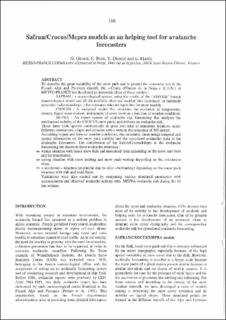| dc.description.abstract | To describe the great variability of the snow pack and to predict the avalanche risk in the French Alps and Pyrenees massifs, the «Centre d'Etudes de la Neige» (C.E.N.) of METEO-FRANCE has developed an automatic chain of three models: SAFRAN: a meteorological system, using the results of the "ARPEGE" French meteorological model and all the available observed weather data (automatic or manmade networks, radio soundings ..) that estimates relevant input data for snow models CROCUS : A numerical model that simulates the evolution of temperature, density, liquid water content, stratigraphy of snow cover as a function of weather conditions MEPRA : An expert system of avalanche risk forecasting that analyses the mechanical stability of the CROCUS snow packs and deduces an avalanche risk. These three tools operate automatically in quasi real time at numerous locations under different orientations, slopes and altitudes with a vertical discretisation of 300 meters. According to past and forecast weather conditions, this automatic chain brings temporal and spatial information on the snow pack stability and the associated avalanche risks to the avalanche forecasters. The contribution of the SafraniCrocuslMepra to the avalanche forecasting are shown in three avalanche situations: => winter situation with heavy snow falls and associated risks depending on the snow rain limit and air temperature. => spring situation with snow melting and snow pack wetting depending on the orientation slope. => «accidental» situation (avalanche due to skier overloading) depending on the snow pack structure with slab and weak layer. Validations were also carried out by comparing various simulated parameters with measurements and observed avalanche activity with MEPRA avalanche risk during the 10 last winters. | en_US |
